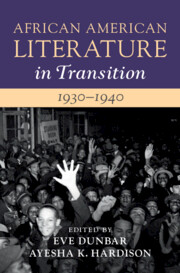Book contents
- African American Literature in Transition, 1930–1940
- African American Literature in Transition
- African American Literature in Transition, 1930–1940
- Copyright page
- Contents
- Figures
- Contributors
- Preface
- Chronology, 1930–1940
- Introduction
- Part I Productive Precarity and Literary Realism
- Part II New Deal, New Methodologies
- Chapter 4 Folklore, Folk Life, and Ethnography in African American Writing of the 1930s
- Chapter 5 New Deal Discourses
- Chapter 6 Black Theatre Archives and the Making of a Black Dramatic Tradition
- Part III Cultivating (New) Black Readers
- Part IV International, Black, and Radical Visions
- Index
- References
Chapter 4 - Folklore, Folk Life, and Ethnography in African American Writing of the 1930s
from Part II - New Deal, New Methodologies
Published online by Cambridge University Press: 25 March 2022
- African American Literature in Transition, 1930–1940
- African American Literature in Transition
- African American Literature in Transition, 1930–1940
- Copyright page
- Contents
- Figures
- Contributors
- Preface
- Chronology, 1930–1940
- Introduction
- Part I Productive Precarity and Literary Realism
- Part II New Deal, New Methodologies
- Chapter 4 Folklore, Folk Life, and Ethnography in African American Writing of the 1930s
- Chapter 5 New Deal Discourses
- Chapter 6 Black Theatre Archives and the Making of a Black Dramatic Tradition
- Part III Cultivating (New) Black Readers
- Part IV International, Black, and Radical Visions
- Index
- References
Summary
This chapter focuses on the writing of Sterling Brown and Zora Neale Hurston, specifically their representations of the folk and folk culture in the 1930s. In addition, it charts the development of their work from the 1920s into the 1940s and World War II. Both writers critiqued the practices and discourses of contemporary ethnography and their assertion of the disappearance of the folk and their culture in the face of modernization, a perspective largely adopted by the politics of the New Deal and the Federal Writers’ Project (FWP). Both writers confirmed the continued relevance and adaptability of Black culture and its place within both the African Diaspora and the national project of the United States so that their work for the FWP produced a counternarrative to its perspective. This chapter argues that a focus on the work of Brown – himself a self-identified leftist – and Hurston demonstrates that the writing of this period does not break down along strictly oppositional lines but is expansive, dialogic, and malleable.
Keywords
- Type
- Chapter
- Information
- African American Literature in Transition, 1930–1940 , pp. 111 - 138Publisher: Cambridge University PressPrint publication year: 2022

